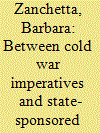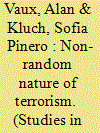| Srl | Item |
| 1 |
ID:
147595


|
|
|
|
|
| Summary/Abstract |
Operation Condor was a transnational network of organized state-sponsored terrorism that targeted Communist “subversion.” It was operational in the second half of the 1970s. The key member countries were Chile, Argentina, Uruguay, Bolivia, Paraguay, and Brazil (Peru and Equador joined the network later on, with a more marginal role). Based on declassified documents from the United Nations High Commissioner for Refugees in Geneva and on U.S. documents of various origin, this article will assess the development of the Condor network and the U.S. reaction to such manifest acts of state-sponsored terrorism.
|
|
|
|
|
|
|
|
|
|
|
|
|
|
|
|
| 2 |
ID:
147593


|
|
|
|
|
| Summary/Abstract |
Although jihadi nasheeds play an important role in the Islamic State's propaganda, there is scant literature on the topic. This article is an exploratory study on seventeen Islamic State nasheeds released between December 2013 and March 2015. The main argument is that Islamic State nasheeds are effective messaging tools because they focus on a limited number of themes that have broad appeal among Muslims. The nasheeds differ from other Islamic State propaganda in their almost exclusive focus on war and fighting, rather than on the softer sides of life in the Islamic State.
|
|
|
|
|
|
|
|
|
|
|
|
|
|
|
|
| 3 |
ID:
147592


|
|
|
|
|
| Summary/Abstract |
We examined the geographic concentration and persistence of terrorism using the Global Terrorism Database (GTD). The GTD logs all terrorist incidents worldwide using open-source media, and, for 1970–2013, includes over 125,000 incidents from over 200 countries and territories. We examined regional and country-level data; different terrorism forms, severity levels, and timeframes (entire period, five-year periods, and annual); and multiple definitions of “elevated” terrorism. The findings reveal that terrorism is concentrated geographically and temporally. Most countries experience peace or very low levels of terrorism; only a few experience substantial outbreaks; very few experience prolonged terrorism; and even fewer, prolonged severe terrorism.
|
|
|
|
|
|
|
|
|
|
|
|
|
|
|
|
| 4 |
ID:
147594


|
|
|
|
|
| Summary/Abstract |
In the last few decades, terrorism has become a global threat and challenge, which many countries have had to face and fight. Conflicts involving terror organizations are, to a large extent, battles of ideas, and are not focused only on physical violence or military confrontation. This reality creates a need to better understand the tools through which terror organizations promote their messages, and to distinguish between different types of terror organizations. The current study examines different types of terror organizations' messages targeting foreign audiences. The analysis focuses on the organizations' usage of public diplomacy in promoting their messages and distinguishes between the different types of organizations (limited- versus total-conflict). Messages promoted by four terror organizations—Hamas and Hezbollah (limited-conflict organizations) and Al Qaeda and the Islamic State (total-conflict organizations)—are analyzed. The findings reveal that while limited-conflict organizations communicate with the international community, and use public diplomacy to try to change the international environment in which they operate, total-conflict organizations do not use public diplomacy; they talk about the international community rather than communicating with it.
|
|
|
|
|
|
|
|
|
|
|
|
|
|
|
|